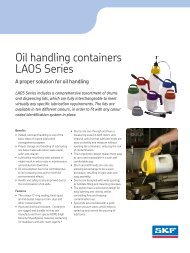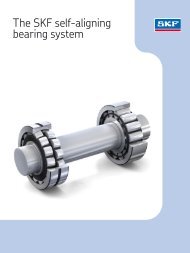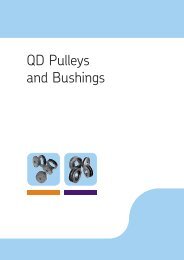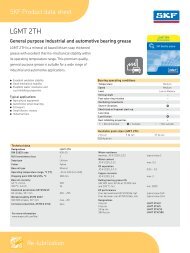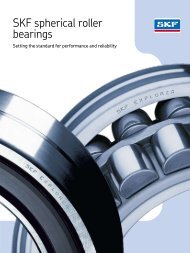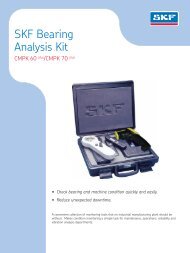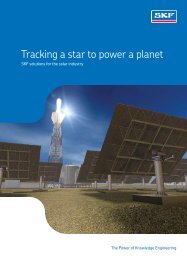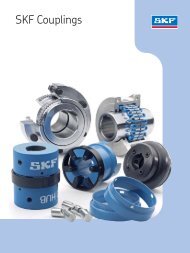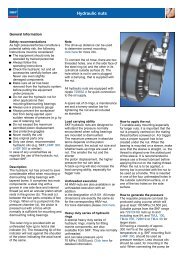SKF Maintenance and Lubrication Products
SKF Maintenance and Lubrication Products
SKF Maintenance and Lubrication Products
You also want an ePaper? Increase the reach of your titles
YUMPU automatically turns print PDFs into web optimized ePapers that Google loves.
R2F grease test rig<br />
ROF+ grease test rig<br />
<strong>Lubrication</strong> ability<br />
The R2F test assesses the high temperature performance <strong>and</strong> lubricating<br />
ability of a grease. A shaft with two spherical roller bearings in their<br />
respective housings is driven by an electric motor. The bearings are run<br />
under load, the speed may be varied <strong>and</strong> heat can be applied. The test<br />
method is carried out under two different conditions after which the<br />
wear of the rollers <strong>and</strong> the cage is measured. Test A is conducted at<br />
ambient temperature <strong>and</strong> a “pass” rating means that the grease can be<br />
used to lubricate large bearings at normal operating temperatures <strong>and</strong><br />
also in low vibrating applications. Test B runs at 120 °C (250 °F) <strong>and</strong> a<br />
“pass” rating indicates suitability for large bearings at high temperatures.<br />
Copper corrosion<br />
Lubricating greases should protect copper alloys used in bearings from<br />
corrosive attack while in service. To assess these properties, a copper<br />
strip is immersed in the grease sample <strong>and</strong> placed in an oven. The strip<br />
is then cleaned <strong>and</strong> the degradation is observed. The result is rated by<br />
a numerical system <strong>and</strong> a rating above 2 indicates poor protection.<br />
Extreme pressure (EP) performance<br />
The 4-ball weld load test rig uses three steel balls held in a cup. A fourth<br />
ball is rotated against the three balls at a given speed. A starting load is<br />
applied <strong>and</strong> increased at pre-determined intervals until the rotating ball<br />
seizes <strong>and</strong> welds to the stationary balls. Values above 2 600 N are<br />
typically expected in EP grease. Under the 4-ball wear scar test, <strong>SKF</strong><br />
applies 1 400 N (st<strong>and</strong>ard test uses 400 N) on the fourth ball during<br />
1 minute. The wear on the three balls is measured <strong>and</strong> values below<br />
2 mm are considered as appropriate values for EP greases.<br />
Fretting corrosion<br />
Vibrating or oscillating conditions are typical causes for fretting corrosion.<br />
Under the FAFNIR test, two thrust ball bearings are loaded <strong>and</strong> subjected<br />
to oscillation. The wear on each bearing is then measured. A wear below<br />
7 mg indicates good fretting protection.<br />
Rolling bearing grease life<br />
The R0F <strong>and</strong> ROF+ tests determine the grease life <strong>and</strong> its high<br />
temperature performance limit (HTPL). Ten deep groove ball bearings<br />
are fitted into five housings <strong>and</strong> filled with a given quantity of grease.<br />
The test is undertaken at a pre-determined speed <strong>and</strong> temperature.<br />
Axial <strong>and</strong> radial loads are applied <strong>and</strong> the bearings run to failure.<br />
The time to failure is recorded in hours <strong>and</strong> a Weibull life calculation<br />
is made to establish the grease life. This information can then be used<br />
to determine re-lubrication intervals in an application.<br />
138




